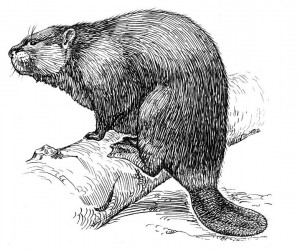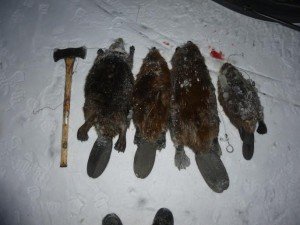 Lower demand for beaver pelts leads to lower prices, which leads to a lower beaver harvest, which lowers the supply of beaver castor. If the demand for castor remains the same (which it has), the only possible outcome is a much higher castor price. That’s what we saw in this week’s Fur Harvesters auction, where beaver prices averaged between $7.56 and $12.05. That’s about as low as it’s been in recent history, and the recent low prices resulted in only around 15,000 beavers offered in the auction. Why trap beavers when the fur is worth so little? With so few beavers offered, castor prices skyrocketed to over $70/lb! Back in 2015, on the heels of high fur prices in 2013-2014, around 25,000 beavers were offered in the same sale, and the same castor topped out at $55/lb.
Lower demand for beaver pelts leads to lower prices, which leads to a lower beaver harvest, which lowers the supply of beaver castor. If the demand for castor remains the same (which it has), the only possible outcome is a much higher castor price. That’s what we saw in this week’s Fur Harvesters auction, where beaver prices averaged between $7.56 and $12.05. That’s about as low as it’s been in recent history, and the recent low prices resulted in only around 15,000 beavers offered in the auction. Why trap beavers when the fur is worth so little? With so few beavers offered, castor prices skyrocketed to over $70/lb! Back in 2015, on the heels of high fur prices in 2013-2014, around 25,000 beavers were offered in the same sale, and the same castor topped out at $55/lb.
We trappers have commented recently about the fact that we’re trapping for castor as much as beaver pelts, and it’s probably the first time in history that the price of castor is approaching the value of the pelt. And the crazy thing is, it takes just a couple minutes to extract castor from a harvested beaver, compared to an hour or two to skin, flesh and stretch a beaver pelt.
 We’ve reached a time in the fur market where we trappers need to consider value of the animals we harvest above and beyond just the pelt. As a group, trappers are thrifty by nature and tend to use as much of every animal as we can, but this market requires we take that thought process to the next level.
We’ve reached a time in the fur market where we trappers need to consider value of the animals we harvest above and beyond just the pelt. As a group, trappers are thrifty by nature and tend to use as much of every animal as we can, but this market requires we take that thought process to the next level.
Beavers are probably the most versatile furbearers when it comes to utility. The pelt is used to make garments, felt hats and other items. The castor glands are used in the perfume industry, as a food flavoring, and as a critical ingredient in many trapping lures – not only for beaver, but many other furbearers. Just below the castors are the oil sacs, which also have a use in the lure making industry.
Unlike many furbearers, beaver meat is very edible. Many trappers are beginning to understand the value of beaver meat as table fare. When fresh harvested and cooked properly, it can be a delicacy. It’s a healthy, natural, lean meat that can be a nutritious byproduct of the trapline. And if the meat isn’t perfectly fresh when retrieved, or your have more than you can eat, lots of other things like it too. Beaver meat is one of the most effective trapping baits there is, and is a base in many formulated commercial baits as well as homemade concoctions. It also makes great dog food, and many sled dog teams in the north are fed beaver meat.
Beaver have unique, flat, leathery tails that can be useful as well. The leather skin on the tail is often used to make wallets and other craft items. Underneath the leather, beaver tails are incredibly fatty. This fat can be rendered down into beaver tail oil, which is a popular ingredient in trapping lures.
In addition to all of those uses, beaver skulls and claws may have some market value as well. And let’s not forget the value of harvesting beavers in maintaining healthy populations and preventing flooding and other animal damage problems. Many landowners are willing to pay for your services if you’re a responsible and effective trapper.
If we think outside the box and maximize all parts of the beavers we trap, we won’t be trapping for just pelts, or trapping for castor. We’re trapping for beavers, and if creative enough, we might just be able to squeeze a small profit out of the beaver we harvest even in a low fur market.
Leave a Reply